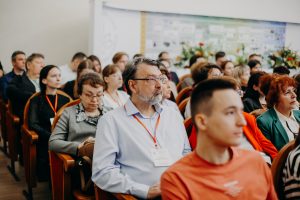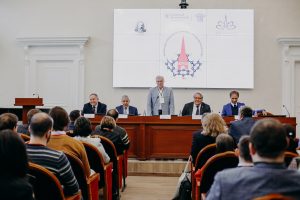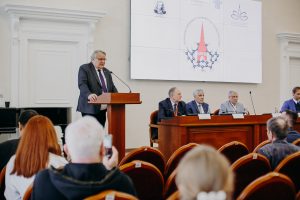10th International Symposium on the Design and Synthesis of Supramolecular Architectures held at the Institute of Chemistry




The event is scheduled for 15 – 19 April.
The forum is dedicated to the 90th anniversary of outstanding chemist Alexander Konovalov (1934 – 2021).
The event is organized by Kazan Federal University, Kazan Scientific Center of the Russian Academy of Sciences, and Russian Chemical Society.
The symposium is attended by major scientists and students from Kazan, Moscow, St. Petersburg, Novosibirsk, Stavropol, Ivanovo, Yekaterinburg, and other cities. Their reports are devoted to various aspects of supramolecular chemistry and related areas of coordination chemistry, nanotechnology, and modern materials science.
On behalf of KFU, the audience was welcomed by First Vice-Rector Dmitry Tayursky. He noted that the symposium is held in the year of 220th anniversary of Kazan University and reminded that in Kazan outstanding discoveries in chemistry were made. The Vice-Rector wished the participants of the event new discoveries.
Valentin Ananikov, Academician of the Russian Academy of Sciences, Deputy Academician Secretary of the Department of Chemistry and Materials Sciences of the Russian Academy of Sciences, said that this year marks another anniversary – the 300th anniversary of the Russian Academy of Sciences. He said that he has been participating in this symposium since the early 2000s and thanked Kazan for its hospitality.
Alexei Kalachyov, director of the Kazan Scientific Center, wished successful work and fruitful discussions.
Andrei Karasik, Director of the Institute of Organic and Physical Chemistry, also welcomed the symposium participants.
“Alexander Ivanovich Konovalov always said that supramolecular chemistry is a bridge between living and non-living matter,” informed Karasik and added that, in his opinion, it is a bridge between molecules and materials.
Professor Igor Antipin, Chairman of the Symposium Organizing Committee, made a presentation dedicated to Academician Alexander Konovalov – who was Rector of Kazan University from 1979 to 1990.
Then Valentin Ananikov (Artificial intelligence and additive technologies in microtonnage and low-tonnage chemistry), Academician of the Russian Academy of Sciences Yulia Gorbunova (Supramolecular chemistry as a tool for fine-tuning the properties of macrocyclic compounds), Associate Professor of the Department of Organic and Medical Chemistry Vladimir Burilov (Functional amphiphiles on the platform of (thia)calix[4]arenes: synthesis, molecular recognition and catalysis) and others presented their reports.
Ananikov’s report was devoted to the development of low-tonnage chemistry and the application of artificial intelligence algorithms and additive technologies in modern chemistry.
“Today, the effects of supramolecular interactions cover many systems, including catalytic systems, which I will talk about,” he reported.
The scientist noted that one of the topics he will cover in his talk is dynamic catalysis. In addition, he will focus on additive technologies.
“By 3D printing plastics, engineering plastics, super-resistant plastics, we can create chemical reactors. I know that this area is actively growing in Kazan. In addition, with the help of laser fusion (metal printing) technology it is possible to obtain chemical reactors for production, including for micro-tonnage chemistry processes,” he said.
Ananikov noted that it is always a great pleasure to accept an invitation to take part in the symposium, which has a history of more than 20 years.
Yulia Gorbunova told about the formation of supramolecular chemistry in Russia, emphasizing that Alexander Konovalov played one of the key roles in its development. She also informed how supramolecular chemistry affects the properties of materials.
“Our group deals with porphyrins – synthetic analogs of natural compounds such as chlorophyll and hemoglobin. Using various supramolecular chemistry techniques, we create new materials with interesting properties based on them. Depending on how you stack the molecules relative to each other, the properties of the materials will depend. For example, molecules can be stacked so that they will glow, or they can be stacked so that they will release reactive oxygen species and work as a strong oxidizing agent or a drug to fight cancer, or they can be stacked so that they will be semiconductors,” Gorbunova explained.

